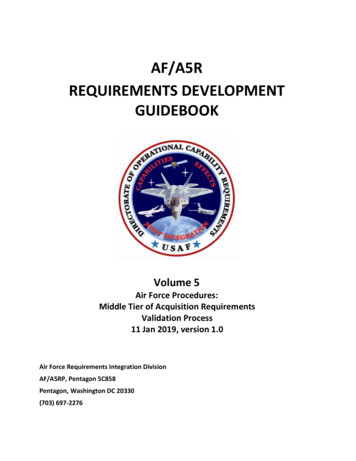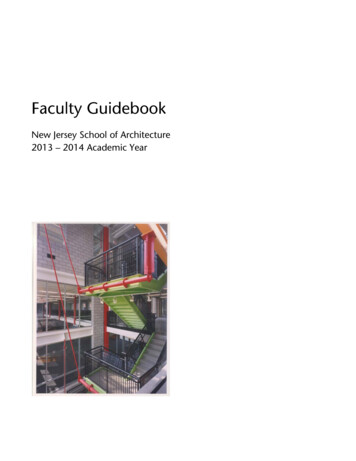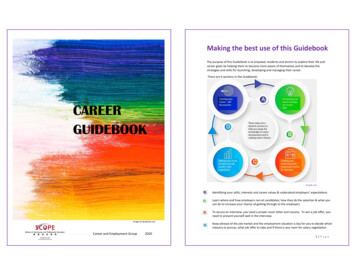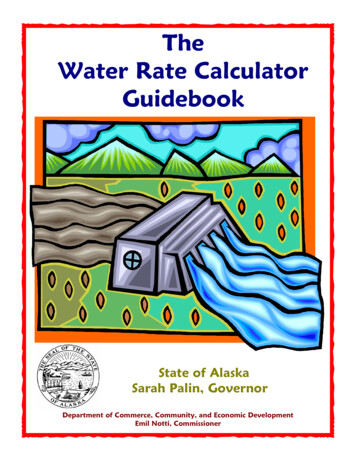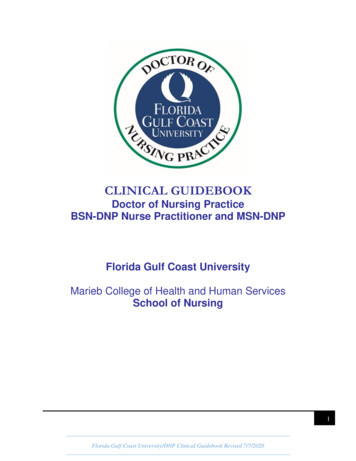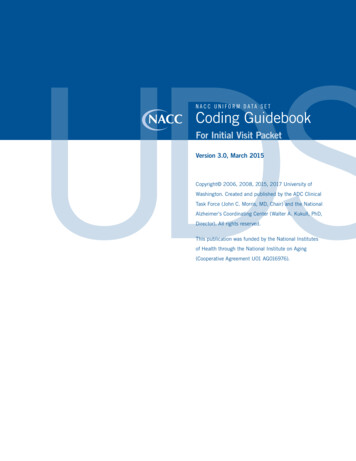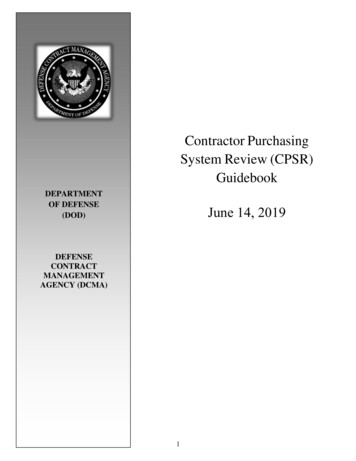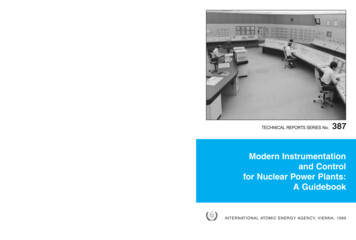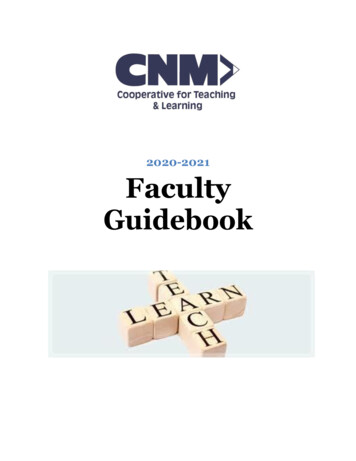
Transcription
2020-2021FacultyGuidebook
CTL Faculty Guidebook, 2020-21: Page ii
Table of ContentsWelcome to CNM1Tips for New Faculty2Welcome . 2Getting Started . 2Essentials . 2Staying Informed. 2CNM Stats3That was then; this is now. 3CNM Structure . 3CNM Vision . 5Mission Statement . 5Core Values . 5Strategic Direction . 5People, Places, & Things7CNM Administration . 7Duplicating Services . 8Faculty ID Cards . 8Dates to Remember . 8Electronic Mail . 9Mailboxes/Mail . 9Supplies . 9Phones . 9Tools & Tricks of the Trade11Philosophy of Teaching and Learning . 11CTL Faculty Guidebook, 2020-21: Page iii
Master Course Syllabus. 12Textbooks . 12Individual Course Syllabus . 13CNM Attendance Policy . 13Assigned Classrooms . 14Waitlists . 14Class Overfill Policy . 14Late Enrollment . 15Dropping Students . 15Discipline Problems . 16Final Exams and Exam Schedule . 17Student Drop-Off and Pick-Up of Finals . 17Grades . 17Grade Books . 17Office Etiquette . 19Classroom Etiquette . 20Professional Topics21Office Hours . 21Faculty Leave: . 21Substitutes, Outside Assignments, Cancellations . 21Professional Development . 22Faculty Evaluation Process . 22Full-Time Faculty Teaching Review . 22Part Time Faculty Evaluation . 23Student Evaluations. 23Tuition Waivers . 23Collegiality . 24Publications. 24CTL Faculty Guidebook, 2020-21: Page iii
Dollars and Sense25CNM’s Years . 25Getting Your Paycheck . 26Substitute Pay . 26Insurance . 26Non-Standard Class Supplies. 27More People, Places, and Things28Distance Learning . 28Duplicating & Postal Center (DPC) . 28Audiovisual Resources (AVS) . 29Learning Resources Center (LRC) aka The Library . 30Tutoring Services: . 30Open Computer Labs . 30Assessment Center . 31Disability Resource Center . 31Counseling, Advisement, Admissions, and Registration . 31Snow Days. 32Security Assistance . 32Parking, ext. 51622 . 33Discounts and Software Checkouts and Purchases . 33Classrooms . 33Hazardous Materials . 34Recycling . 35Mediation . 35Addendum A - “How to Survive and Thrive” . 41Essential Preparations for Faculty . 41Addendum B - CNM Acronyms . 51CTL Faculty Guidebook, 2020-21: Page iii
Welcome toCNMThis guidebook will serve as a reference, and assist you in your primaryresponsibility of teaching, by addressing many of the concerns you may haveabout:o ruleso policieso procedureso who’s whoo resourceso contingency planso tips for teachingThis guidebook augments, but does not replace, the Governing Board Policy Handbook,CNM Employee Handbook, Collective Bargaining Agreement, Student Handbook, andthe CNM Catalog, all of which take precedence over this document.This guidebook was adapted from the Applied Technologies Faculty Guidebook by theCooperative for Teaching and Learning (CTL) New Faculty Support Team (NFST). Forthe most up-to-date information on policies and procedures at CNM, please refer to theCNM website or talk to your Faculty Chair or Associate Dean.CTL Faculty Guidebook, 2020-21: Page 1- should update
Tips for New FacultyWelcomeYour first few weeks of teaching may seem daunting, overwhelming and challenging.Hang in there. As you become more familiar with CNM’s rules and regulations, policiesand procedures, the pace will become more manageable and agreeable. Refer to thisGuidebook often. This valuable resource was created to provide information, insight,and answers to support your continued success at CNM.Getting StartedAfter attending orientation, you will need to get your CNM ID, textbooks andancillaries, the master course syllabus, books for your class, and the name of yourFaculty Chair. These can be obtained from your Associate Dean and/or the Chairof your department.Check with your school’s Administrative staff for your office assignment and the officephone number to put on your syllabus. Also, find out how to use the voice-mail systemyou will use in your office or at home.Your school’s Administrative staff is a valuable resource for information about supplies,equipment, audiovisual needs (Audio Visual Services), computer equipment (ITS), andfacilities. Find out how to access your classroom and arrange to obtain keys (ifapplicable) and alarm codes immediately. If you teach in a computer lab, arrange to findout about logins, passwords and directory locations from a program colleague. Shouldyou have questions regarding any operational or practical matters, ask anyadministrative staff, who will direct you to the proper resource or person. Refer toAddendum B: “How to Survive and Thrive: Essential Preparations.”EssentialsReview CNM’s Philosophy of Learning and Teaching, included herein, as you prepareyour individual course syllabus, modeled after the relevant master syllabus. Be sureyour syllabus contains all of the required sections the students (and others) will beexpecting. Check with your Faculty Chair to find out where the electronic copies ofmaster syllabi are stored in your School.Many of the procedures outlined in this guidebook are completed through myCNM andthe Web for Faculty site. A Web for Faculty Guide is found as Addendum D to thisguidebook.Staying InformedCheck your CNM e-mail often. You will receive e-mails with important deadlines orrequests, College and School information, and student correspondence.CTL Faculty Guidebook, 2020-21: Page 2
CNM StatsAuthorized by the State Legislature in 1963, CNM, formerly TVI, opened officiallyon July 1, 1965. Its goal was to provide adults with marketable skills and therelated education needed to succeed in an occupation. This remains CNM’smission. CNM has grown in the ensuing decades to become the largest institutionof higher education in the state.That was then; this is nowThe Institute’s first classes were held for 150 students in a vacated elementary schoolbuilding, surplus army barracks, and cottages. Since then enrollment has increased tomore than 28,000 students who attend classes at seven sites: Main campus, nearAlbuquerque’s downtown business district and UNM; Joseph M. Montoya campus(JMMC), in the far northeast heights; a full-service facility on the Westside at Universeand Irving (WS); the South Valley campus (SV) in Albuquerque’s southwest quadrant;Advanced Technology Center (ATC) located near I-25 and Alameda and the Rio RanchoCampus is located in Rio Rancho’s City Center—close to Rio Rancho City Hall, SantaAna Star Center, Hewlett Packard, and UNM Health Sciences Rio Rancho campus. TheWorkforce Training Center (WTC), at 5600 Eagle Rock NE, also hosts classes as neededbut primarily offers non- credit training. CNM has also expanded to include otherbusiness/ academic ventures that include CNM Ingenuity and Ingenuity Software labs,Space Solutions, and more.CNM’s first 21 years were devoted to offering certificate and diploma programs inbusiness, technologies, and trades as well as continuing education courses in theseareas. The major expansion in mission came in 1986 when the New Mexico Legislaturegave CNM the power to grant associate degrees. Approval by the CNM Governing Boardquickly followed and the Institute’s move toward becoming a community college began.CNM StructureCNM Academia is divided into six separate schools. School specific policies andprocedures may vary, so it is important to attend individual school and/or departmentmeetings as directed by Administration. Brief descriptions of the individual schools andtheir programs are as follows:The School of Adult & General Education (SAGE) helps students progress intheir academic and career pursuits through a variety of support courses and programs.Courses are offered in a variety of formats (collaborative, self-paced, distance) so thatstudents can choose the course that best fits their learning style. Developmentaleducation courses are graded credit (CR) or no credit (NC). Adult & General Educationoffers day and evening courses at all campuses as well as distance learning courses.Programs include: First Year Seminar, Developmental Education, English as a SecondLanguage, English for Speakers of Other Languages, and GED Preparation.CTL Faculty Guidebook, 2020-21: Page 3
The School of Applied Technologies (AT) includes students, industry partners andskilled teaching professionals, coming together in an environment of, relevant appliedlearning. Their aim is to enable students to gain the technical knowledge and skills tofurther their career, educational, and personal goals. Programs include: AdvancedManufacturing Technology, Apprenticeships, Pre-Architecture, Architectural/EngineeringDrafting Technology, Automotive Technology, Aviation Technology, Carpentry,Construction Management Technology, Construction Technology, Diesel EquipmentTechnology, Electrical Trades, Film Technician, Geographic Information Technology,Heating, Ventilating, Air Conditioning and Refrigeration (HVAC), , Machine ToolTechnology, , , , Plumbing and Gas Fitting, Surveying Engineering, Truck Driving,Unmanned Aircraft Systems (Drones) and Welding.The School of Business & Information Technology (BIT) offers certificate anddegree programs that provide knowledge and skills in a variety of business andtechnology related fields. Their programs prepare students for direct entry into theworkplace upon completion of a certificate or degree program. BIT offers two FastTrack degree programs in Business Administration and Computer Support Specialist.Associate of Arts programs are transfer degrees which allow students to substantiallymeet lower-division program requirements for Bachelor degrees in those fields.Programs include: Accounting, Baking, Brewing and Beverage Management, Business,Business Administration, Business Analytics, Computer Information Systems,Computer Science, Culinary Arts, Culinary Fundamentals, Digital Media Marketing,Entrepreneurship, Food Service Management, Hospitality and Tourism, IntegratedStudies, Medical Office Assistant, Office Assistant, Office Administration, OfficeTranscription, Project Management and Retail Management. BIT also offers thefollowing Computer Information Systems concentrations: Cloud Technology,Computer Programming, Computer Support Specialist, Cyber Security, Digital Media,Network Administration, Systems Administration and Web Programming.The School of Communication, Humanities & Social Sciences (CHSS) providesliberal arts courses which support degree and certificate programs, including theAssociate of Arts degree in Liberal Arts and General Studies. All courses are transferableto other degree-granting institutions as frosh and sophomore electives or requirements.Programs include: Alternative Teacher Licensure, American Sign Language, AmericanStudies, Anthropology, Child Development, Communication, Criminology, EarlyChildhood Multicultural Education, English, Environmental Planning and Design, FineArts, History, Human Services, Infant Family Studies, Latin American Studies, LiberalArts, Modern Languages, Native American Studies, Online Teaching and Learning,Political Science, Pre- Architecture, Pre-Law, Psychology, Sociology, Spanish Interpreter,Teacher Education, and Theatre.The School of Health, Wellness & Public Safety (HWPS) is committed toproviding a positive learning experience to improve, enrich and expand opportunities instudents’ lives. They offer credit and noncredit programs that lead to certificates,associate degrees and skill upgrading. Most programs have prerequisite classes andrequired courses that must be completed with a grade C or better. Although some of theprograms are open enrollment, many of the programs require an admission orCTL Faculty Guidebook, 2020-21: Page 4
application process for admission (Coordinated Program Entry). H W P S p rogramsinclude: CNM Law Enforcement Academy, Community Health Worker, Cosmetology,Criminal Justice, Dental Assisting, Diagnostic Medical Sonography,Electroneurodiagnostic Technology, Emergency Medical Services, Exercise Science andWellness, Fire Science, Health Information Technology, Health Services Management,Home Health Aide, Medical Assistant, Medical Laboratory Sciences, Nursing, NursingAssistant, Paralegal Studies, Patient Care Technician, Pharmacy Sciences, Phlebotomy,Physical Therapist Assistant, Radiologic Technology, Respiratory Care, SurgicalSciences, and Veterinary Sciences.The School of Math, Science & Engineering (MSE) provides a strong academiccurriculum in support of students pursuing certificate programs, associate degrees orplanning to transfer. A wide variety of courses in Astronomy, Biology, Biotechnology,Chemistry, Computer Science, Earth and Planetary Science, Engineering, Geography,Mathematics, Nutrition, and Physics are offered. Most courses are transferable to otherdegree-granting institutions as freshmen and sophomore electives or requirements.College and Career High School. In fall 2013, CNM and Albuquerque Public Schoolsteamed up to open a high school on CNM’s Main Campus (EC Building) It providesstudents with a curriculum that focuses on dual credit opportunities, allowing students tograduate from high school with a CNM certificate, associate degree or enough collegecredits to enter a university as a junior.CNM IngenuityCNM Ingenuity supports a new approach to learning that provides accelerated educationaland training opportunities in key workforce areas including technology and healthcare,wrap-around support for aspiring entrepreneurs, and cooperative ventures that fostereconomic development and job creation. Since being established in 2014, CNM Ingenuityhas made tremendous progress on behalf of Central New Mexico Community College andthe economy.Our Guiding PrinciplesCNM VisionChanging Lives, Building CommunityMission StatementBe a leader in education and training.Core ValuesCTL Faculty Guidebook, 2020-21: Page 5
Be Caring, Be Ethical, Be Inspiring, Be Courageous, Be Connected, Be Exceptional.Strategic DirectionStudent Success: Ensure learning and support that promotes student persistence inachievement of education and training goals. Implement and measure the impact of strategies to promote student retentionand success. In support of CNM Value: Caring Identify and implement strategies to support successful student completion andtransfer. In support of CNM Value: Caring Increase number of degrees and certificates awarded. In support of CNM Value:CaringCommunity Success: Lead and support high value workforce and communityengagement. Advance CNM as a leader in workforce and economic development. In support ofCNM Values: Excellence and Caring Timely, relevant, honest assessment of diverse community needs, and agility torespond. In support of CNM Values: Leadership and HopeIdentify and nurture strategic partnerships. In support of CNM Value: Leadership OrganizationalExcellence and Innovation: Define CNM as a high quality organization andtransformational workplace. Advance the quality journey to measure and improve performance outcomes, topromote evidence-based decision-making, and to promote a culture ofaccountability. In support of CNM Values: Leadership and Excellence Advance a culture for caring and responsive support and service. In support ofCNM Values: Respect and Caring Create and sustain a diverse system for growth, development and support ofemployees. In support of CNM Values: Respect, Caring and Hope Clarify and articulate the distinct and dynamic identity of CNM. In support ofCNM Value: CaringCTL Faculty Guidebook, 2020-21: Page 6
People, Places, & ThingsCNM AdministrationCNM PresidentTracy HartzlerVice President for Academic AffairsDr. Sydney GunthorpeDeansFor up more information see Academic Affairs website address at:http://www.cnm.edu/depts/academicaffairs SAGE - LouAnne Lundgren AT – Amy Ballard (interim) BIT – Kaylynn Pirkl (interim) CHSS – Melanie Viramontes (interim) HWPS - Carol Ash MSE – Philip ListerAssociate Deans SAGE – Nora Nixon and David Valdes (interim)AT – Joe Schuab and Sharon Gordon- MoffettBIT – Sionna Grassbaugh and Rochelle Overton (interim)CHSS – Zachary Shank and Danizete Martinez (interim)HWPS –Erin Johnson-Kruft and Matthew ThomasMSE – Philip Carman and Brian Sailer (interim)ChairsFor more information see Academic Affairs website address at:http://www.cnm.edu/depts/academicaffairsFaculty OfficesOn Main campus, your office space will be designated by your school administration orfaculty chair. All keys to offices, desks, and cabinets are checked out from must bereturned if you leave CNM’s employment, at the end of a term if you are not teaching thesame course next term or as indicated by school administration. If you are teaching atCTL Faculty Guidebook, 2020-21: Page 7
one of the other campuses (Advanced Technology Center, Joseph M. Montoya, RioRancho, South Valley, Westside, or Workforce Training Center), campus administrativestaff will designate your office/cubicle space. Please keep in mind that space may beshared with other faculty.Duplicating ServicesFor large copy requests, use the Duplication and Postal Center (DPC). They are quickand efficient and provide many printing services. Requests are submitted through DPC’sCommunity Insights page and the link to the insights page is available enter . The DPC is located in thePhysical Plant building. A cost account number associated with your program isrequired for processing your copy request. Contact the Administrative staff in yourschool for this account number.Alternatively, you can access the copiers located at all campuses. Some copiers arelocated in rooms that require a password, a CNM ID card, and/or door key. Check withschool or campus Administrative staff for access. For more information go to the CNMwebsite address at: Faculty ID CardsPhoto identification cards are obtained at Main Campus from the Student ServicesCenter (SSC 109), Montoya Campus (TW Building, Room 103), South Valley Campus(SV-40), and Westside Campus (WSII, Room 104). IDs are required and should be kepton your person when you are on campus. They are also required to check out itemsfrom the libraries, to access the workroom and certain classrooms, and to get discountsfrom the bookstore. Please encourage your students to obtain ID cards during the firstweek of classes. For more information go to the CNM website address officeSchool CalendarThe schools of Applied Technologies (AT), Business Information Technology (BIT),Communications, Humanities and Social Sciences (CHSS), Health, Wellness & PublicSafety (HWPS), Math, Science and Engineering (MSE), and Adult and GeneralEducation (SAGE) have two 15-week terms (fall and spring) and, a 12-week summerterm. There are many parts of term (POT):14 weeks, 12 weeks, 8 weeks, 6 weeks, 5weeks and intersessions. The year’s instructional calendar is published in several forms,but the catalog gives it in detail, including holidays and breaks between terms.Academic Year Calendars can be found lendarsCTL Faculty Guidebook, 2020-21: Page 8
Dates to RememberPublished each term, “Dates to Remember” is just that: a list of important dates,deadlines, and meetings. Updates are made to the webpage that can be accessed fromthe CNM homepage at: e/important-dates-and-deadlinesParts of TermPublished each term, the “Parts of term” chart lists, for each part of term, the start andend dates, last day for refunds, last day to drop and financial aid disbursement dates.Updates are made to the webpage that can be accessed from the CNM homepage edule/parts-of-termCTL Faculty Guidebook, 2020-21: Page 9
Electronic MailOutlook MailAll faculty need and are expected to access Outlook e-mail accounts. Usernames andpasswords are assigned after the Human Resources orientation. An InformationTechnology Services (ITS) representative will help you get your account set up on youroffice computer. You can also access your account via the web at: http://owa.cnm.edu.Issues with email, computer labs and computers should be addressed to ITS ServiceDesk. servicedesk@cnm.edu or 224-help.Mailboxes/MailWhen paper correspondence is addressed to you, you’ll find it in the mailbox assigned toyou by your school’s or campus administration. Mailbox assignments may be changedeach term so check for your name to identify which is yours.Inter-campus mail is delivered by courier Monday through Friday. Place material in abrown Campus Mail envelope and leave it in the appropriate bin in the faculty work areafor pick up. Be sure to specify which office and campus your delivery is for.SuppliesYour school or campus administrative staff can help you procure supplies such asstationery, folders, tablets, pens, pencils, and chalk.NOTE: Always carry chalk or white-board pens with you to class.For supplies that must be ordered you will follow your individual school’s policy.PhonesAll offices and faculty areas have telephones and all are on the same system with a 224prefix. Dial the five-digit extension when using a campus phone to reach an extensionor dial 9 and the phone number for an off-campus line.Employees are provided with voicemail. Faculty and staff can be reached from an offcampus phone by dialing 224-4000 and entering the five-digit extension. Your extensionand password, as well as instructions, will be provided to you by school administrativestaff. After you have a password, dial 224-4801 (or 44801 on campus), then followinstructions to check messages. All of your voice mail messages show up in your CNMemail account, so you don’t need to call the number above to access your voicemailmessages. Additional information can be found online tegy/cisco-unified-communicationinformationCTL Faculty Guidebook, 2020-21: Page 9
CTL Faculty Guidebook, 2020-21: Page 10
Tools & Tricks of the TradePhilosophy of Teaching and LearningWe believe that learning occurs best in a positive learning environment with a teacherwho serves as a facilitator of learning. The learning environment shall be physicallycomfortable; promote mutual trust and helpfulness; accept individual differences; andacknowledge the experience of learners.We also believe that learning is promoted when the learner is ready to learn, acceptsresponsibility in the learning process, participates actively in the learning process, and iscommitted to making progress toward achieving goals.We further believe instructors should— involve students in the learning process help students clarify their learning needs stimulate intellectual curiosity create a climate conducive to learning project a positive attitude about students’ ability to learn recognize students as individuals listen attentively to what students say be responsive to student needs convey to students an attitude of mutuality with regard to the enterprise of learning state student learning outcomes and implement appropriate means for students tomeet outcomes present ideas clearly and respectfully present updated materials and information in a prepared and well-organizedmanner use a variety of teaching/learning methods give corrective feedback promptly to students develop mutually acceptable criteria and methods for measuring progress toward thelearning outcomes communicate effectively with students, colleagues, administrators, and communityleaders use community resources maintain currency in their fields of expertiseCTL Faculty Guidebook, 2020-21: Page 11
Master Course SyllabusAll courses have master course syllabi written by faculty members. Master syllabi are tobe used by all part-time and full-time faculty. These documents help to maintainconsistency in the department’s curriculum and facilitate transferability to otherinstitutions and accreditation for many vocational programs.Some parts of a master syllabus may not be changed when creating an individual coursesyllabus including: course description, texts, objectives, CNM attendance policy, andCNM grading scale.The required textbook must be listed and used. Instructors may add to the coursedescription, objectives, and material covered but not delete from it. All syllabi musthave a list/schedule of assignments and due dates for the term. Master syllabi areavailable electronically.See an Associate Dean or the Faculty Chair if you have any questions regarding thenature or use of master syllabi. Every time you teach a course, request a copy of itsmaster syllabus which you will use to create your individual syllabus. Master syllabi arereviewed and revised regularly, chiefly when new textbooks are chosen for a course.Workshops in individual syllabi writing are available.TextbooksTexts are selected by the department. Additional materials for courses may be listed onthe book order form as optional or required. The school’s administrative office or theFaculty Chairs compile these forms for the student textbook order and submits the orderto the campus bookstore.Instructors may advise students that certain books are available from sources other thanthe campus bookstore; however, because some grant and scholarship recipients MUSTbuy their books at the CNM bookstore, an order should be placed with the Bookstore forall texts and materials needed for the course. Follet, which is the company that runs theCNM bookstore, has an exclusive contract with CNM so instructors may not list othersources for books on the class syllabus.Faculty members are issued texts for courses taught. All issued textbooks, teacherguides, reference books or other materials remain property of CNM and must bereturned upon termination of employment with the college or if you are no longerteaching that course.Textbook Adoption Policy:You may review the Academic Affairs Textbook Adoption Policy athttp://www.cnm.edu/depts/academicaffairs/AA pdfs/AA Textbook Adoption Procedure final.pdf. Check with your Faculty Chair for your department policy.CTL Faculty Guidebook, 2020-21: Page 12
Individual Course SyllabusEach course section you teach must be given a syllabus that follows the master coursesyllabus. One syllabus for each different course you teach is kept on file to answerquesti
all equipment for you. Please note that you will need to stay in your classroom, with the equipment, until an AVS staff member returns for pick-up, at the pre-arranged time. Listed below are the contact numbers: Main Campus 224-3306 Rio Rancho 224-4921 Montoya 224-5746 ATC 224-5139 Westside 224-5322 WTC 224-5200
